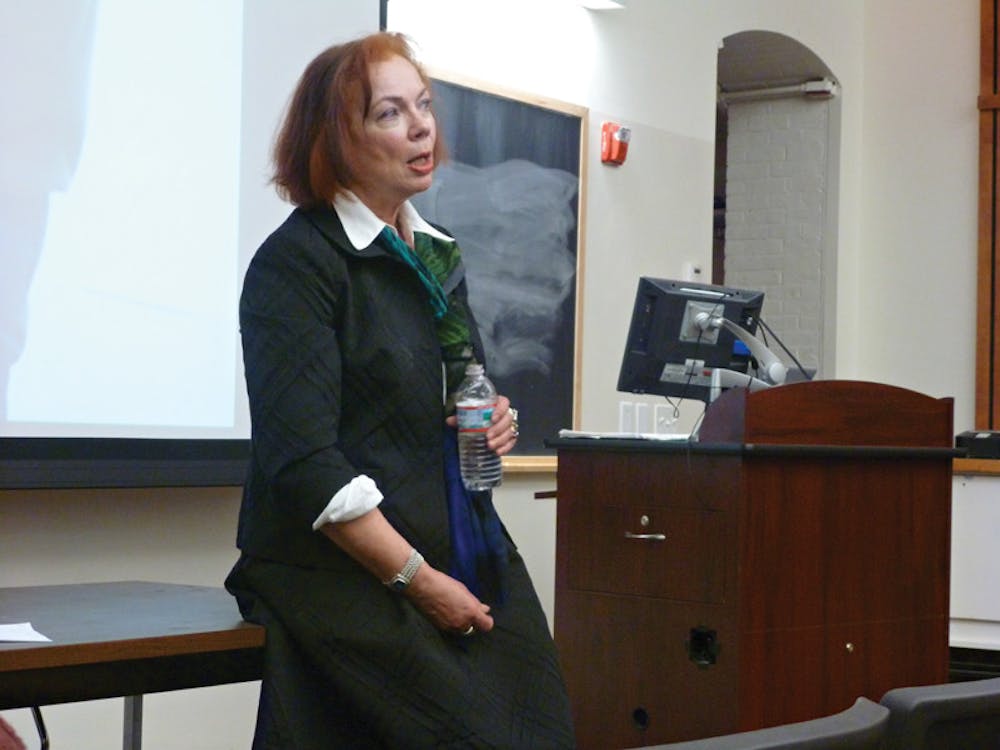Displaying six photographs of video game players’ “game faces” to a crowd in Wilson 102 Tuesday night, Barbara Stafford, professor emerita at the University of Chicago and visiting professor at Georgia Institute of Technology, said, “This is not my topic.”
People who play video games often look like they are deep in thought, but to really pay attention, people must “be aware of (their) awareness,” Stafford said, rather than just acting automatically. She said she is interested in these deeper, more conscious attention processes, rather than more automatic actions.
Stafford’s lecture, titled “The Long Conscious Look: Attention as a Burning Topic in the Humanities and Neurosciences,” was the first of three talks in the spring Science and Technology Studies lecture series “Beyond the Two Cultures: The Future of Science and Technology Studies.”
An expert in vision and image perception, Stafford focused on the intersection between vision, images, attention and neuroscience. Through various examples, she explored attention in terms of art and visual perception. “Where is attention at any given moment? It’s kind of hard to say, isn’t it?” she asked.
Stafford also spoke of “memory as a creative process” and showed a picture of a woman named Jana, the grandmother of Czech artist Katerina Seda. Jana went into a depression after her husband died, and Seda asked Jana to draw objects from the hardware shop she managed years before, thinking it would be therapeutic. Jana could draw 650 items and label them with prices, a process in which she drew from long-term memory. For the art to come into existence, Seda had to dedicate attention to her grandmother, and Jana had to transform her long-term memories into short-term memories, bringing them into her immediate attention once more.
In her lecture, Stafford combined research and material from the humanities as well as research from neuroscience about the prefrontal cortex, consciousness and the perception of images. She focused both on attention itself and on the way the brain pays attention. Many of the issues she mentioned could form the basis of important projects for future interdisciplinary research, Stafford said.
She also urged students to think about the way electronic devices control behavior, asking, “How much do they target your attention?” She looked at the distractive role of electronics and pointed out that while scientists used to believe people could focus on five or six activities at the same time, scientists now think it is difficult to focus on even just two.
Stafford ended her lecture by reiterating the relationship between perception and art. Scientists and humanists have “lost sight that conscious vision dilates perception,” she said.
For researchers in different fields, working together requires “learning about one another at a higher level,” Stafford said.
Vanessa Ryan, an assistant professor of English who researches the relationship between cognition and literature, said she was impressed by the variety of people who attended the lecture. “What’s most impressive is to have people from neuroscience, the humanities and students all in the same room. … It’s a relatively rare success,” she said.
Doug Nickel, professor of modern art, called the lecture a “great demonstration of what is likely to be the future of Science and Technology Studies.”
Jasmyn Samaroo ’13, a student in ENGL1900Z: “Neuroaesthetics and Reading” this semester, said the class and the lecture both show the “bridge between humanities and sciences and what they offer each other.”
Stafford said that when a student involved in a vision lab through the cognitive science concentration came up to her after the lecture, it was “music to (her) ears.”
She added that for students interested in the intersection of the humanities and sciences, it is important to “ground yourself in both areas” and to find the right topic that will draw an audience from multiple disciplines.

ADVERTISEMENT




